A Lexicon for Open Fields of Exchange: On the Language and Dynamics of Researching Towards a Social Sensibility
Zandie Brockett with Alessandro Rolandi
To cite this contribution:
Brockett, Zandie, with Alessandro Rolandi. ‘A Lexicon for Open Fields of Exchange: On the Language and Dynamics of Researching Towards a Social Sensibility.’ OAR: The Oxford Artistic and Practice Based Research Platform Issue 1 (2017), http://www.oarplatform.com/lexicon-open-fields-exchange-language-dynamics-researching-towards-social-sensibility/.
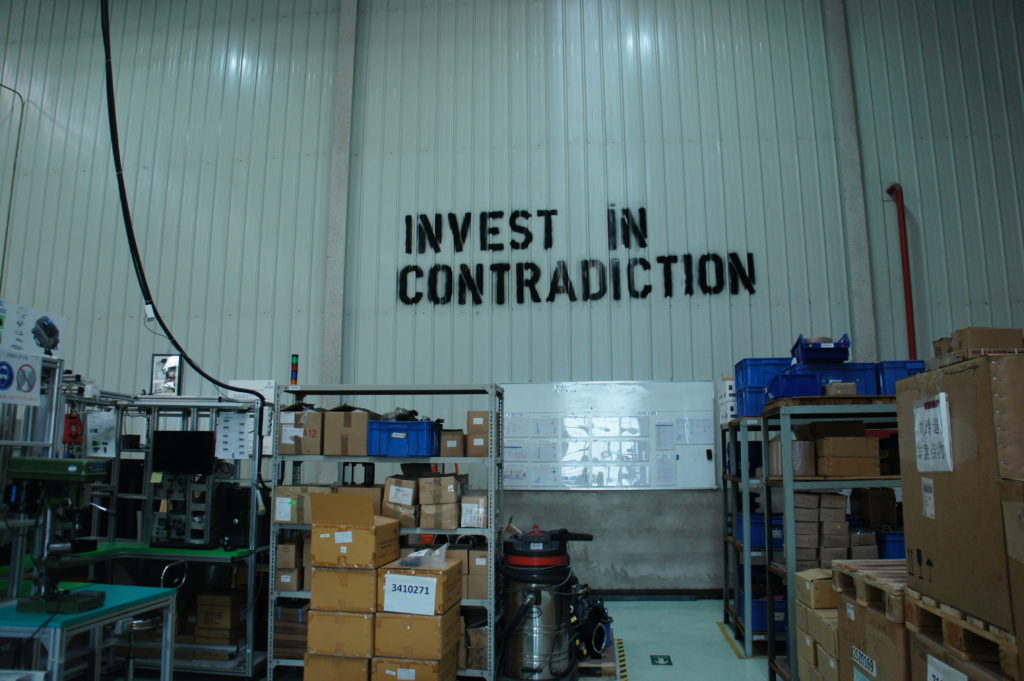 Ma Yongfeng’s Invest in Contradiction spray painted on the Bernard Controls factory wall (SSR+D project number 2), courtesy of Social Sensibility Research + Development.
Ma Yongfeng’s Invest in Contradiction spray painted on the Bernard Controls factory wall (SSR+D project number 2), courtesy of Social Sensibility Research + Development.
Assemble, paint, test, order, receive, process, survey; these are a few of the actions the 90 workers at Bernard Controls’ Beijing actuator manufacturing plant encounter and perform daily.1 Occurring at workstations specific to each step of the actuator’s production, the processes are enacted by workers trained to perform each task at hand. In Discipline and Punish: The Birth of Prisons, Michel Foucault’s 1977 inquiry into the formation of institutional systems, the philosopher notes that the aim of disciplinary training and the establishment of heterogeneous enclosures specific to the execution of each action was
to establish presences and absences, to know where and how to locate individuals, to set up useful communications, to interrupt others, to be able at each moment to supervise the conduct of each individual, to assess it, to judge it, to calculate its qualities or merits. It was a procedure, therefore, aimed at knowing, mastering and using the human body in order to increase its economic utility.2
However, in being trained to execute a skill, the worker is then simultaneously subjected to the control of the organizational hierarchy and the embedded power dynamics that govern work relationships.
In considering the success and sustainability of a company, the organizational systems that Foucault mentions restrict the employees’ potential for building meaningful and trusted relationships that propagate the communication of information and new ideas. What, then, are the contexts that invite unstructured and spontaneous dialogues outside the influence of organizational demands or operational frameworks? How can the partial suspension of disciplinary systems, organizational hierarchies and performance metrics create fields or forums that encourage employees to connect and exchange information and ideas that circumvent the organization’s conventional modes of communication? And, how does this relatively more open conversation and free-form dialogue help employees develop a ‘social sensibility’ that enables them to develop both meaning and purpose independent of the economic system to which their labor is contracted, while simultaneously adding value to the organization’s operations?3
Organizing ‘open fields’ around the Bernard Controls’ factory, the Social Sensibility Research and Development (SSR+D) department facilitates open-ended research towards a more flexible social dynamic within the organization. It should be noted that the term ‘open fields’ does not suggest a complete or achieved state of openness, but rather a process allowing for the temporary suspension of presiding social institutions such that information can move and be shared more freely. In avoiding conventional objectives and evaluation procedures of product research and development (R&D) departments, SSR+D invests in the future of the company – in the future of its employees. The family-owned Bernard Controls believes ‘shareholders are no more ‘owners’ of the company than parents are ‘owners’ of their children because the future of the company belongs not to them, but to their employees’.4 By ‘investing in the future of the people’, states Bernard, the company seeks to research ‘possible modes of [organizational] existence where specialized physical and psychological environments as well as [manufacturing processes and corporate] systems are challenged, [and does so by] introducing a symbiotic relationship that alternates the existing organizational dynamic’.5 Bound to a lesser extent than traditional organizations by organizational hierarchies or processes that can impede communication, the SSR+D department cultivates tactics for SSR+D projects use various ‘divergent gestures’ that encourage communication and mutual learning between employees.6
Since 2011, SSR+D has facilitated 39 social practice art projects that demonstrate how the temporary or partial suspension of organizational procedures, hierarchies and measurement frameworks encourages open dialogue amongst factory workers. Taking place as a series of artists residency projects, each of which occurs over three to six months and during which the artist works at the factory one to two days per week, the artists’ use various ‘divergent gestures’, or tactics to freely engage workers in conversation about inter-organizational issues. In doing so, these projects arguably help workers cultivate aptitudes and capabilities, or ‘social sensibilities’ that better empower them to maneuver complex organizational relations. By subtly manipulating or contradicting the factory’s disciplinary system – training programs, manufacturing workflows and organizational hierarchies that professionally arrange the human body in time and space for technological progress, efficiency and economic gain – the resident artists’ also give employees opportunities to share information and learn from each other in ways alternative to the conversation patterns created by the organizational status quo. Finally, it has been observed that these conversations have brought greater meaning and purpose to people’s role as employees beyond that of contracted laborers.
This paper explores the actors, methods and results of the social research conducted by the SSR+D department by presenting a new lexicon through which these topics can be discussed in both organizational and art contexts. Organizational behaviorists, Chip and Dan Heath note ‘every culture, whether national or organizational, is shaped powerfully by its language… [for the incubation of a new language] reflects a new set of values.’7 This new language attempts firstly, to develop a framework to assist the SSR+D department and other social practice artists apply these tactics to their own research-driven art practices, and secondly, to provide both Bernard Controls and other interested organizations the possibility of adopting similar practices in their own companies. These terms have been devised both by the authors of this text as well as in response to those used by resident artists who have worked on projects facilitated by the SSR+D department. The examples listed under each term are not indicative of the situation in which the terms were first created, but rather illustrate its use. Finally, each term is given a subgenre, namely people (who), place (where), goal (why), process (how), so that readers can better understand the usage of each term.
Lexicon
Agents (People)
Agents are the factory’s employees, including workshop employees (i.e. assembly, painting, packaging or quality control), office employees, middle managers and directors (i.e. marketing, finance, research & development), and administrators and other staff (i.e. reception, housekeeping). It is important to note that agents are not just product-assembling employees in the factory’s workshop. Agents do not include the artists brought into the organization through the SSR+D department. The term references the agency someone possesses (latent or not) to enact change by being a conduit for the creation and communication of new ideas and information.
Amateurism (Goal)
The amateur is the key figure in a future contributive economic model. By cultivating sensibilities, workers develop tools of self-expression and self-development needed to mitigate the destined disappearance of their manufacturing role that is threatened by automation. Furthermore, in disrupting the social institutions that guide employee behavior within the organization, the SSR+D department promotes new forms of communication and encourages the vitality of the amateur worker that is not ‘motivated by profit or pay, [but rather by] ideas and values not tied down to any profession… this vision is often more expansive, more eclectic, and not hampered by the conservatism of narrow expertise, preoccupied with defending one’s intellectual turf.’8 It is speculated that by preserving amateurism in the professionalized work environment through the presence of art projects, workers’ capacities for self-expression and self-development are heightened.
Additionally, amateurism maintains a dimension of knowledge and independence that extends beyond the sphere of functionality and labor. It helps the agents develop a set of ‘working skills’ that they can exchange in contribution to their sustained existence in community life (i.e. a mechanic uses his skills to fix the neighbor’s car in return for that neighbor – a woodworker – constructing a small structure). The reciprocal and spontaneous exchange of these services helps build a culture and community based not on monetary remuneration, but instead on sharing and exchange.
At the Bernard Controls factory, five agents have been directly involved with the Work/Live project (see ‘Facilitator’) and have started making artwork during work hours. While primarily using break times, these workers continuously return to the SSR+D office on their own time to paint, journal and converse with SSR+D facilitators. In taking the initiative to fill their free time with activities that build sensibilities, the agents protect their individual liberties and abilities to form community.9
Divergent Gestures (Process)
Research towards a social sensibility is qualified by the introduction of unmediated gestures that seek not to optimize the output of a laborer, but rather to punctuate or contend with the organizational processes that constrict the worker. The intention of these gestures, or dynamic points of dissonance, are not to create shock value, but rather to generate meaningful reactions that lead to open dialogues, extending beyond those ordinarily had within the organization’s politically correct framework.
By using divergent gestures that emphasize interaction, inquiry, and process over isolated production and end product, resident artists challenge the organizational status quo with activities, scenarios or sites that engage agents in tasks or conversations beyond those required of them as employees. Some artists ‘use humor, while others use pedagogical methods, some look for internal collaborators and partners, and others count merely on their own presence’.10 Further, some use role-playing as a gestural tactic to engage individuals in discussing narratives that create collective empathy towards a particular issue. These divergent gestures are
process-driven modes of production that are detached from both the object and the scripted nature of performative works. [They are different] from socially engaged projects in that they do not solicit participants to enact prescribed roles or actions.11
Moreover, by provoking intimate and open communication between various members of the organization, artists provide opportunities for new ideas, habits and social institutions to enter the organization. In a comparative analysis of similar ‘art intervention’ programs in Europe, researcher Ariane Antal notes that
when artists enter organizations with their “foreign” cultural norms, practices and codes, they are expected to disturb the “local” cultural codes and practices while they try to discover how to engage with their new setting. The interactions should generate dissonance (Stark 2009), offer alternatives and spark off new possibilities for exploration from which members of both cultures can learn.12
Developing divergent gestures triggers agents to generate common forms of communication. These are processes of mutual learning and exchange that ‘entail listening to each other to come to a shared understanding and agreement about the way forward. In almost all the cases where the artist arrived with a proposal, the ideas changed under the influence of the interaction with the context’.13 It has been observed that the artists who use most of their time engaging with the employees, assimilating into the company culture, and demonstrating an authentic interest in listening to employees in order to create personal bonds, have been the most fruitful in helping factory workers develop sensibilities. Rolandi states
whenever the agent-artist interaction leans too much towards serving pure artistic purposes or toward serving company-related objectives, the quality of the interaction decreases exponentially. When both parties manage to use art not as an end in it of itself, but as a tool to communicate and elaborate about their condition, the quality of the exchange reaches an interesting level, which while difficult to articulate, is clearly perceived by those around.14
The success of these gestures revolves around their ability to suspend or diverge from the optimized use of time and space as seen in conventional organizational processes. Through repeated exposure to these divergent gestures, agents’ gradually gain awareness of both their surrounding environment and colleagues, grow the sense of trust with these environments and colleagues, and in doing so, find new communication techniques. This is synonymous with the development of a social sensibility. Artist and SSR+D consultant Tianji Zhao comments
for me, the process of this project is equally, if not more important as the outcome. First it’s an encounter – we have a conversation about the current living-working condition in general, and then through many meetings, memories begin to surface, as well as delicate subjects and intriguing imaginations. Together we dig deeper into one concept, we look at other artists’ works that might have a similar approach in form material or message, and see if it’s possible to conceive something original. The research of art making doesn’t stop with art, it creates the potential for exploring personal emotions and thoughts, and it builds a closeness through time and trust. Time is a key factor, a project can be truly root itself and grow by giving it enough time to develop – it’s the same as relationships between people.15
After several conversations with the agents, artist Ma Yongfeng’s project No. 2 subverted the meaning of the company’s motto, ‘Invest in Confidence’, by mimicking provocative Maoist-era propaganda banners. In writing ‘Invest in Contradiction’ high above the assembly line on the factory’s wall, he reminds the organization and its employees that variance rather than certainty, leads to innovation, growth and long-term sustainability. Other slogans such as ‘Action is Product’ and ‘First Check on Yourself, then Check on Others’ as well as quotes by workers such as ‘Communication is a River’ were spray painted onto cardboard typically used for actuator packaging. The work is direct and visually aggressive, imposing its existence into workshop space. To this day, ‘Invest in Contradiction’ is still imprinted onto the factory wall, embodying the very spirit of the department and its facilitated projects.
In another example, artist Lulu Li developed SSR+D project No.4, Human Products. As a short performance, Li invited then plant manager, Gilles Urhweiller, to become an actuator. Like all actuators, Uhrweiller was assembled, painted, packed and put into storage. By using humor as a gestural tactic to disrupt the tensions arising from the stratification of power between the plant manager and workshop employees, Li provides workers an opportunity to challenge the organizational hierarchy, formulate a sense of trust through the possibility for a more intimate conversation, and commence a more casual dialogue with senior management.
Facilitator (People)
The SSR+D department as well as individuals were invited to broker and negotiate artist projects within the host organization (i.e. Bernard Controls). Note facilitators can be artists, but are not in all cases. The status of facilitator is dependent on the individual’s relation to the agents. Namely, facilitators serve as bridge between the cultures and habits of the artists and the organization, the facilitator’s role nears that of a translator, ensuring that ‘differences and dissonances between the cultural codes can be resources, not barriers’.16 Facilitators also ‘function as “guarantors,” because their reputation, resources and, on occasion, legal cover[age is] at stake’.17 In order to challenge normative employee behavior, disrupt stagnant flows of information, and encourage sensibility exchange through the organizational network, facilitators use ‘direct and physical presence of contact and engagement, egalitarian and voluntary forms of communication and information exchange, and long-term physical commitments to relationships’.18
An illustrative example of facilitator’s at work is seen in the Work/Live project that Rolandi and Zhao developed in late 2015. Part of the newly founded Social Sensibility Research Institute (SSRI), Work/Live is a series of projects where agents create artworks in response to their living and working environments and social and psychological conditions. These works are exhibited in galleries and art spaces outside the factory context. Sharing books with images and textual references of noted artworks, Rolandi and Zhao serve both as educators helping agents to conceptualize their work as a form of self-expression or commentary, and also as producers to help materially create the artwork. As an extension of the Work/Live project, Rolandi and Zhao also organize weekly conversations between Guillaume Bernard, COO of Bernard Controls worldwide and Director of Bernard Controls China, and workers in locations and times chosen by the worker. In doing so, a new dynamic is created regarding the role, responsibility and attitude of the worker towards both middle and upper management. The Work/Live project as well as the bike shed-tearoom project (see ‘Open Fields’) have demonstrated Zhao’s capacity to listen to and respond to the agents’ demands beyond those propelled by her personal artistic desires. Her projects and requests have often touched upon sensitive issues and have encountered resistance, thus allowing her presence and role as a facilitator to be perceived as valuable.
Open Fields (Place)
In reference to social fields, open fields are both physical and non-physical (social or psychological) spaces, scenarios or environments where the presiding organization’s rules and regulations are temporarily suspended and whose function is undefined and unmediated. Like a magnetic field or a quantum field, where the movement of energy takes place in a seemingly random but still patterned manner, these open fields are constantly changing spaces where information and sensibilities are exchanged between agents.
However, unlike the fields as proposed by sociologist, Pierre Bourdieu, or the fields in field theory, open fields strive to deconstruct hierarchy, remove competition and attain relative neutrality in respect to the social relations of the engaged participants. An individual’s status given their role within the organizational hierarchy comes secondary to the mutual trust and respect that is held between colleagues given the possibility for exchange. Moreover, within these open fields are composed of constant and complex micro-interactions; highly codified spaces are subtly hijacked and slowly transformed in ways that may be partial, temporary, or exist merely as a proposal that is refused. This softening of institutional structures creates small openings, triggering new interactions and reactions, or allowing small opportunities to bypass the rules. Given the partial or temporary disruption and shift of institutional norms, habits and behaviors, agents gain new perspectives that create new ideas and are instilled with a sense of confidence when sharing these ideas or sensibilities.
Like most fields, open fields are not stable. Nevertheless, these open fields attempt to maintain a constant negotiation between interacting agents to ensure that judgment is minimized, and that the intended mode for interaction as dictated by the organizational hierarchy does not completely overpower the exchange. The ability for these fields to stay open and non-competitive is what characterizes their nebulous forms. The negotiation of these open fields is what provides the practice and experience needed to develop a social sensibility.
These open fields are synonymous with ‘spaces for play’19 in so far as ideally the interactions occurring within them are ideally organic, spontaneous and encouraging of both experimentation and the possibility of failure. They are also similar to ‘free spaces’, or ‘small-scale meetings where [agents] can gather and ready themselves for collective action without being observed by members of the dominant group. Free spaces often play a critical role in facilitating social change because it is in these spaces that the organization’s constituents can digest, reflect upon, discuss, and implement new organizational boundaries, rules, and policies or processes for engagement and interaction’.20 In the case of SSR+D, both the department as well as each artist can be a facilitator of open fields that ‘maintain spontaneity and disturbance within the company’s day-to-day activities’.21
In SSR+D projects No. 27 and No. 35, Tianji Zhao worked together with Australian artist Matthew Greaves to improve recreational common spaces for factory workers. By turning a bike shed into a tearoom that served as a site for conversations with all factory employees during the summer months, the artists provided a physical, open field, or a commons, in which agents could gather, smoke cigarettes and discuss topics of their choice. It is in these discussions that various codes and boundaries imbedded in the working environment were unveiled. Such work can be idealistically called a ‘open field’ because it strives to create a space where hierarchies and rules are temporarily suspended. Of course, as with the proverbial ‘water cooler’,22 the possibility for more fluid social interactions does not imply the complete dissolution of power structures. Nevertheless, the Zhao and Greaves’ tearoom remains a site more open than others in the factory to fluctuate between coded interactions on the one hand and greater neutrality and spontaneity on the other.
Research and Development (Process)
Research and development is a controlled process that enables the continued profitability of a corporation by innovating products, machine technologies, supply chains or production processes and systems, and organizational or managerial strategies that increase the competitive capacity and efficiency of a corporation. R&D is often an investment in the future, where ‘development’ implies short-term and ‘research’ indicates long-term investments in the company’s future. While R&D permits organizational flexibility given the prospect of innovation, this permission is still bound to a regulated framework that determines the use of an employees’ time, the manufacturing space, and the company’s capital, material and labor investment. It is a process that is not entirely open to experimentation and as such, its potential to generate truly new ideas is limited.
While conventional product R&D departments are tasked with missions of innovation, the spaces, temporalities, processes, and resources determined by organizational systems constrict the open-ended possibility of those objectives. Bernard notes that while ‘commonly associated with innovation, [product] R&D can be quite restrictive because it is done within a specific physical place and by a specific team’.23 Product R&D is also constrained by evaluation metrics, such as Key Performance Indicators (KPIs) that speculate on the potential future value of R&D projects in order to justify the corporation’s invested resources.
SSR+D breaks prevailing R&D processes in that it does not answer to market demands, the invested interests of stakeholders or organizational timelines. Since a core tenant of the SSR+D mission is to remain non-proscriptive such that the facilitated introduction of divergent gestures can remain as spontaneous reactions to real time scenarios, conversations and relationships, the department must remain sensitive to the organization’s internal changes. Whether responding to a subtle shift, such as the hiring of new employees, or a larger one, such as the construction of a new office space within the factory, the department must constantly assess and renew programming to protect against the normalizing influences of the organization’s structure, inertia, and time.
It should be noted that working in real time is incredibly risky for an organization that typically orients its operations on at least a quarterly, if not annual planning schedule. However, the ingenuity of SSR+D as a department is grounded in its ability to be guided by an intuitive quality that solves issues through action-oriented processes rather than by the calculated analysis of a scenario and application of a formulaic response or procedure.
Social Sensibility (Goal)
Sensibilities are social skills, emotional capacities or creative aptitudes that help individuals listen, learn, and adapt to other agents in real time. These sensibilities, developed in open fields facilitated by SSR+D often encourage agents to have intimate conversations with colleagues in other departments and of higher organizational status, to have the confidence in proposing new ideas or solutions to work issues, and to maneuver complex work relationships dictated by formal disciplinary systems. Sensibilities are manifested in various capacities, including but not limited to negotiation, observation, communication, collaboration, leadership, and adaptive skills for dealing with individual or organizational ambiguity.
Following the ‘Mere-Exposure Effect’ or ‘Familiarity Principle’, a psychological term used to describe how people’s interest towards something increases in direct correlation with increased exposure to outside elements, social sensibilities arise as agents are exposed to divergent gestures. By engaging with dialogues and artistic projects existing outside normalized work procedures or diverging from the organizational hierarchy, agents sometimes latent sensibilities are activated and they are empowered with a new found confidence and sense of purpose.
It is important to acknowledge that social sensibilities are not considered to be forms of innovative ingenuity. Innovation is an industry term that emphasizes a profit driven end. Social sensibilities attempt to bypass the profit objectives of often competitive organizational relationships, and focus instead on the emotional sensitivities that enable workers to approach problems with different intelligences. Moreover, the term has an underlying essence that seeks to maintain the idea of free will amongst those who possess it, such that he or she can be an active participant in processes of transformation and community building. As such, embedded within the definition of social sensibilities is an inherent quality of being unquantifiable.
Over a series of conversations in British artist Celyn Bricker’s project No. 37, Traces, worker Zhao Tao was engaged in the factory’s actuator-painting booth; the project is demonstrative of the rise of Zhao Tao’s sensibilities. Bricker asked Zhao to participate in his project by standing in front of white paper he mounted to the booth’s walls, serving as a quasi-stencil. Posing for Bricker’s performative paintings, Zhao added his own touch by doodling abstract forms onto the paper. When completed, the two discussed the randomness of the work they had collectively made, specifically debating whether the outline of Zhao’s body was or was not a work of art, and if so, the implications their collaboration had on issues of authorship. After these conversations Zhao became enthusiastic and curious about art making, and it was then that he volunteered to participate in the Work/Live (see ‘Facilitator’) project. Using the actuator packing foam, Zhao produced foam sculptures that were inspired by stories and memories of his childhood mountain village. The works were compiled into the series, Badlands, which was exhibited in the Beijing independent art space, Arrow Factory. Since the exhibition, Zhao has continuously developed his creative practice, making works such as a sound piece in which he delivered the election campaign speech, ‘If I was the mayor of my village’. Zhao was one of the first agents who became aware of the impact art could have on his life outside of his job as an actuator-painting technician.
Sensibility Exchange | Mutual Learning (Process)
The exchange of information or ideas occurring over an extended duration of time, taking place within open fields of exchange, and whose rate is positively correlated with the engaged agents’ possession of sensibilities. Sensibility exchange is similar to usership, a term first coined by cultural theorist, Stephen Wright. Usership is a ‘process of personalization, or “using” latent information that allows factory workers to gain confidence in and willingness to negotiate inter-personal relationships with colleagues and managers’.24
In Megumi Shimizu’s Petit Movement (project No. 3), the Japanese artist stimulated interaction between agents by engaging them in drawing and performance exercises. In asking them to symbolically communicate their work environment to their colleagues, they were able to illuminate issues of behaviors and boundaries determined by the organizational culture. The project convinced agents to enact a ‘small movement’, within which they would communicate the meaning of their position in the factory to others on their teams. Agents responded with both absurd and provocative as well as subtle and passive gestures that helped to establish amongst them a strong empathetic bond.
Conclusion
The SSR+D department facilitates the introduction of divergent gestures into the organizations daily operations that create open fields and help agents form new communication habits built on trust and mutual respect. It is through these relationships that agents have an increased propensity to cultivate, share, and discuss new ideas about problems produced by organizational hierarchies, practices, and systems at Bernard Controls’ Beijing factory. In doing so, the social practice art projects, facilitated by SSR+D, produce research towards alternative scenarios and environments that enable factory workers to embody the spirit of the amateur laborer and give meaning and purpose to their labor beyond a professional contribution to the organization. Moreover, the bilateral exchange of sensibilities amongst agents reframes the relationship between the organization and its constituents, and enables the possibility for agents’ to actively participate in the organization to which their labor is contracted. By decoupling the use of time and space with traditional KPIs that guide conventional R&D departments, SSR+D presents new, unbounded sites of research that are conducive to more spontaneous forms of dialogue and agency.
This paper presents the birth of the Social Sensibility Research + Development lexicon, which will be continuously revised and expanded as the project progresses and the Social Sensibility Research Institute gains traction with the Work/Live project. The process of developing this new language has mirrored that of developing sensibilities. It is a practice-led process, negotiated through constant dialogue with artists and members of the organization’s various departments. By relying on the input and feedback from various members of the Bernard Controls community and invited SSR+D artists, this language attempts to negotiate the established discourses within the fields of social practice and organizational behavior, and provide an alternative ground in-between them. In doing so, this lexicon hopes to bring a structured logic to artists seeking to challenge the cliché of provocative art that borders on activism, and rather cultivate a practice of sensibility that can assist workers to re-negotiate their labor environments.
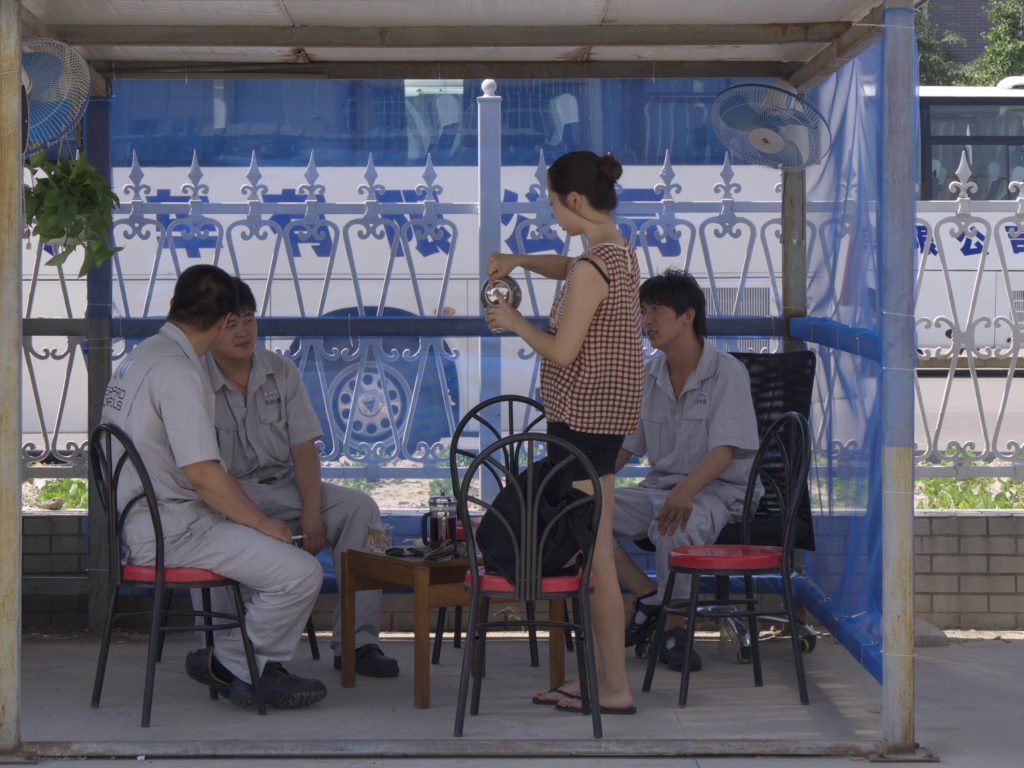
Tianji Zhao pours tea for factory workers in the bike shed-turned-tearoom, designed in collaboration with Matthew Greaves (SSR+D project number 27), courtesy of Social Sensibility Research + Development.
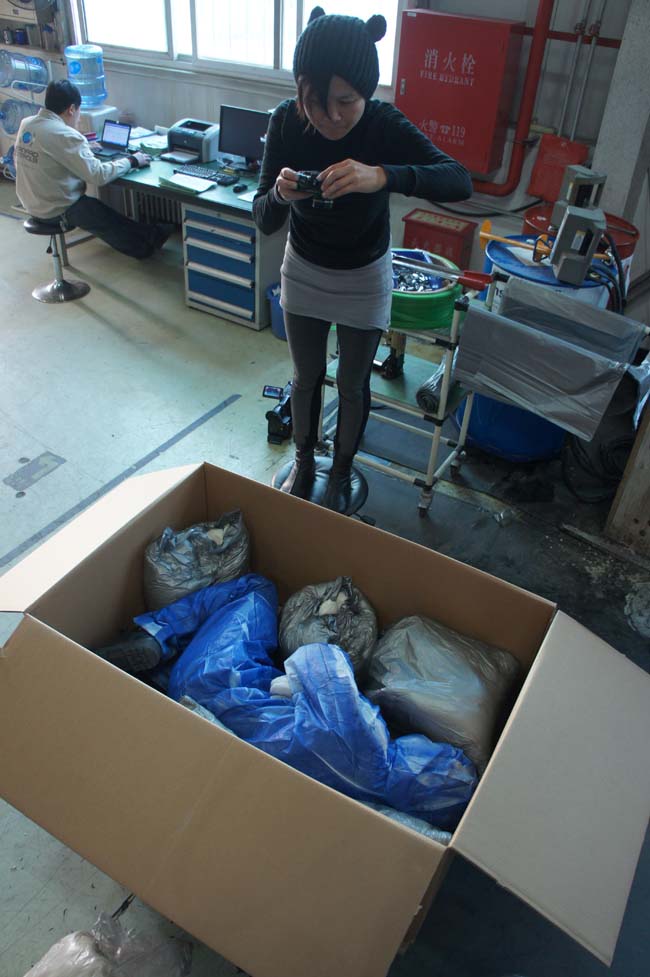
Lulu Li photographs Gilles Urhweiller as he is packaged like an actuator (SSR+D project number 4), courtesy of Social Sensibility Research + Development.
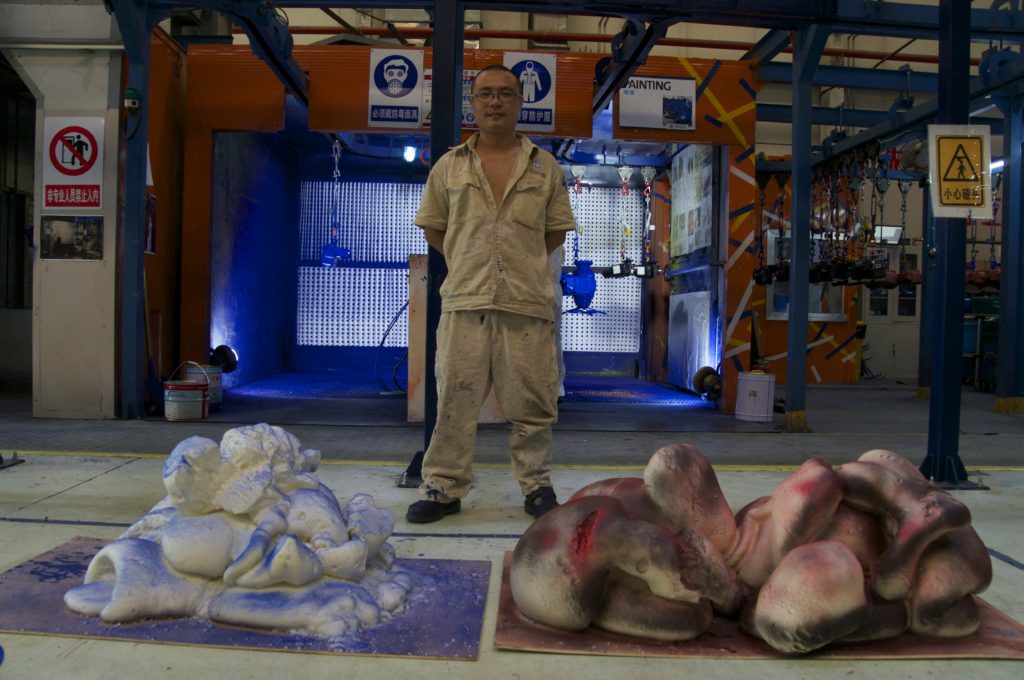
Zhou Tao stands behind his foam sculptures crafted in collaboration with Celyn Bricker (SSR+D project number 37). Courtesy of Social Sensibility Research + Development.
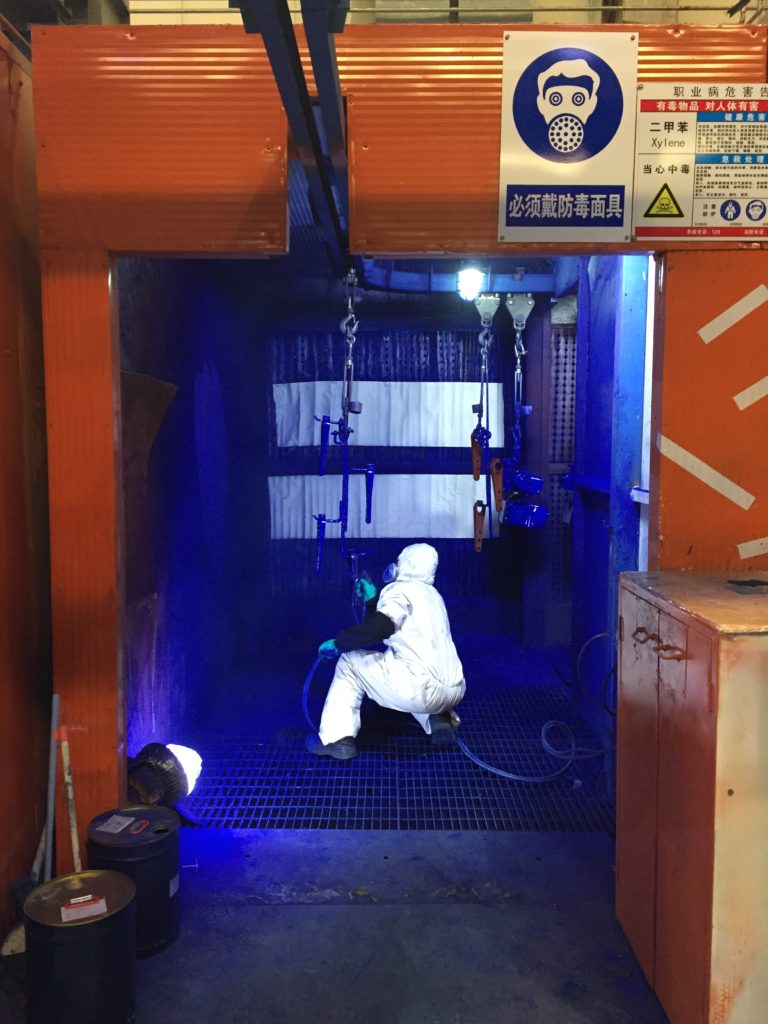
Celyn Bricker prepares the paper and spray paint before Zhou Tao enters into the painting booth (SSR+D project number 37). Courtesy of Social Sensibility Research + Development.
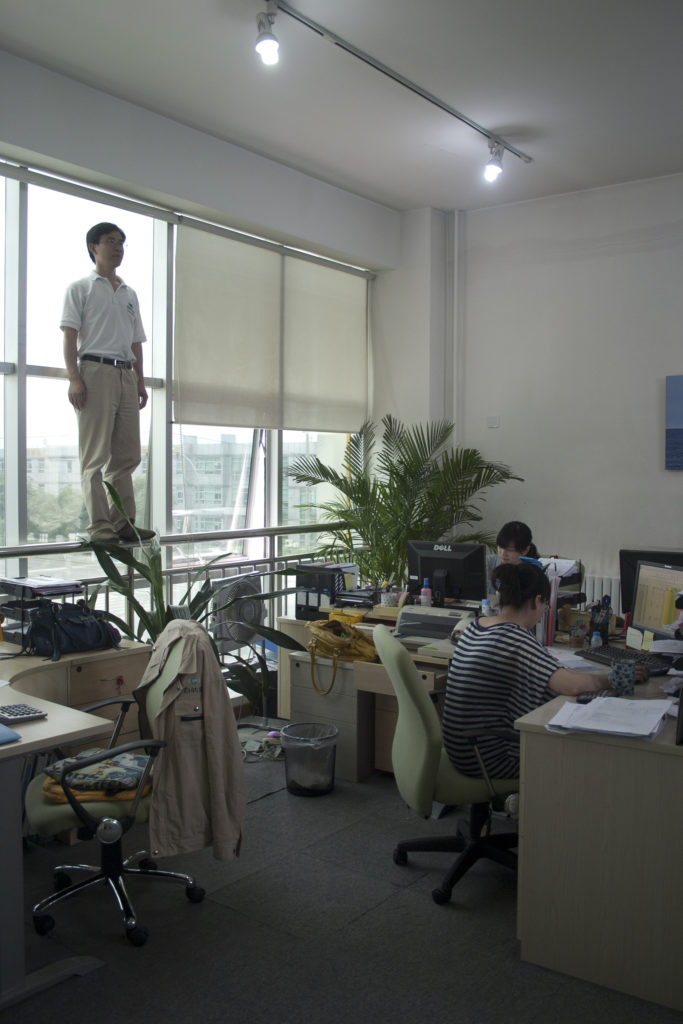
Manager stands above his team as a part of Megumi Shimizu’s Petit Movements (SSR+D project number 3). Courtesy of Social Sensibility Research + Development.
1. An actuator is a mechanical component that is used to move or control a mechanism or system (Wikipedia); it is often understood as a valve. It the case of Bernard Controls, the factory produces actuators for oil, gas and water pipelines.
2. Michel Foucault, Discipline and Punish: The Birth of the Prison, trans. Alan Sheridan (New York: Vintage, 1995), 143.
3. Due to the ethical dilemma surrounding a need to emancipate the enslaved worker, as posited by Karl Marx, there is a tendency to focus critical discourse on the systems that constrain the manual laborer or factory worker, rather than on those employed within an office or managerial position. It is one that arises from an ideological association between the industrial and manufacturing site – the factory – as one of the prime locations for the exploitation of labor. Certainly there is reason for concern of the instrumentalization of the worker’s social interactions for the benefit of the corporation’s profit driven objec tives, but this paper alongside the SSR+D department chose not to focus on the pitfalls of this potential form of exploitation for several reasons. Firstly, due to the small-size, family-run nature of the 120-person Beijing factory, there is a genuine desire to aid the workers condition. As referenced in the text’s introduction, the Director of the Beijing factory believes that the sustainability and future success of the workers is dependent on its worker’s well being. So, while this critique might be just for a large, multinational corporation that is driven by bottom lines and optimized operations, the company culture at Bernard Controls makes this a moot point. Secondly, by focusing on the exploitative nature of the employer-employee relationship in all competitive capitalistic systems, it denies the possibility that the relationship might bring positive value to the worker beyond the disadvantaged state to which he is already bound. It is in this later example that the complex dynamic of the symbiotic relationship between the SSR+D department and the company is formed, because while the SSR+D department provides Bernard Controls a platform to increase its potential for sustainability and innovation, the company also provides the department valuable resources to help workers develop sensibilities that can be translated for use outside of the work environment. As such, this text focuses on the process of negotiation or mutual learning and exchange between these two parties. In emphasizing sustainability over competition, the establishment of mutually shared or complimentary goals allows both parties to win in a game that typically has a fatalistic end for one.
4. Guillaume Bernard, ‘Guillaume Bernard on SSR+D,’ telephone interview by Zandie Brockett, January 15, 2017.
5. Alessandro Rolandi, ‘Alessandro Rolandi on SSR+D,’ telephone interview by Zandie Brockett, June 25, 2016.
6. Ibidem.
7. Chip Heath and Dan Heath, Switch: How to Change Things When Change Is Hard (New York: Crown Business Publishing, 2010).
8. Andy Merrifield, ‘Intervention – “Future Shock,”’ Antipode, June 9, 2015, accessed January 10, 2017, antipodefoundation.org.
9. There is a critique to be made about agents’ participation in the SSR+D artist projects in that first, those who decide to be more deeply engaged with the projects tend to be given more free time and flexibility in their break schedule, which is currently allocated as 10 minutes, twice a day. Second, agents’ wishing to be involved in creating artwork in spaces provided to them by the SSR+D department must use their break time, rather than additional time during the work day allocated to partaking in SSR+D related projects. There is a tension, however, between the time the factory can give to workers to partake in SSR+D projects and the time the factory contacts them to produce the company’s product. Ultimately, the workers’ primary function is to provide a labored service.
10. Rolandi,‘Alessandro Rolandi on SSR+D.’
11. Zandie Brockett, ‘A Space For Play: On “Social Sensibility Research and Development” and the Construction of Commons in Urban China.’, Proceedings of Overwhelming Imaginations Conference (Beijing: Sishang Museum of Art, 2016), 112.
12. Ariane Berthoin Antal, ‘Artistic Intervention Residencies and Their Intermediaries: A Comparative Analysis,’ Organizational Aesthetics 1:1 (2012): 44-67, Digital Commons, 46.
13. Idem, 56.
14. Rolandi,‘Alessandro Rolandi on SSR+D.’
15. Tianji Zhao, ‘Notes on SSR+D Zhao,’ January 2, 2017.
16. Antal ‘Artistic Intervention,’ 60.
17. Idem, 61.
18. Rolandi,‘Alessandro Rolandi on SSR+D.’
19. Brockett, ‘A Space for Play,’ 107-116.
20. Heath, Switch, 246.
21. Rolandi,‘Alessandro Rolandi on SSR+D.’
22. The water cooler example proves that invaluable information is passed through the organization not in formal memos or reports, but rather in informal environments, such as during a break in the office’s kitchen or near the water cooler.
23. Bernard, ‘Guillaume Bernard on SSR+D.’
24. Brockett,‘A Space for Play,’ 113.
About the authors:
Zandie Brockett 张桂才 is a curator, writer and researcher from Los Angeles, though has lived and worked between Beijing and Shanghai since 2011. She has served as the Associate Curator of the Shanghai Project, the founder of Bactagon Projects (Beijing), the Editor-in-Chief of 八家 BaJia. Her research investigates the sociological effects of art when introduced into labor systems, explores the impact of mass-urbanization on social networks, daily practices and identity formation, and develops new financial models for sustainable cultural organizations.
Alessandro Rolandi is a multimedia and performance artist, director, curator, researcher, writer and lecturer living in Beijing since 2003. His work currently focuses on social intervention and relational dynamics to expand the notions of art practice beyond existing structures, spaces and hierarchies as a means of engaging directly with reality in multiple ways. He is the founder and director of the Social Sensibility Research & Development Department at Bernard Controls since 2011.
